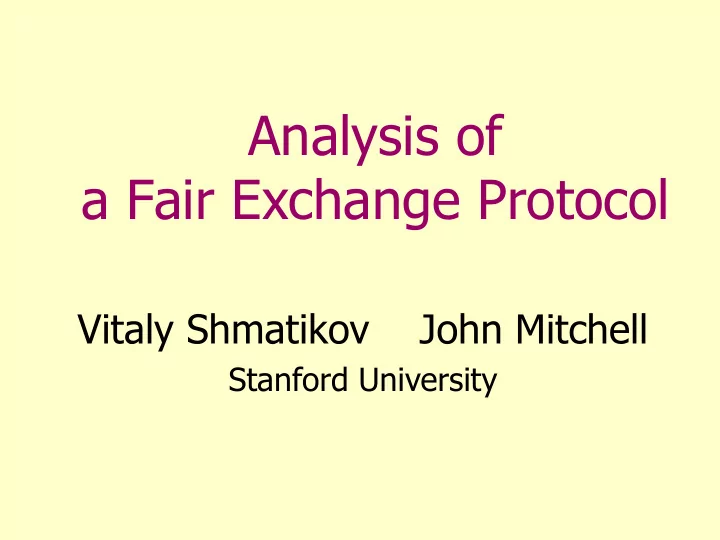

Analysis of a Fair Exchange Protocol Vitaly Shmatikov John Mitchell Stanford University
Agreement in Hostile Environment Cannot trust the communication channel Cannot trust the other party in the protocol Trusted third party may exist Last resort: use only if something goes wrong
Contract Signing Immunity deal Both parties want to sign the contract Neither wants to commit first
Fairness If A cannot obtain a contract, then B should not be able to obtain a contract, either (and vice versa) Example (Alice buys a house from Bob) If Alice cannot obtain a deed for the property, Bob should not be able to collect Alice’s money
Accountability If trusted party T misbehaves, then honest party should be able to prove T’s misbehavior Example (Alice buys a house from Bob) If escrow service gives Bob Alice’s money without giving Alice the deed, Alice should be able to prove to a judge that escrow service is cheating
Formal Protocol Analysis Informal Formal Intruder Protocol Protocol Model Description Gee whiz. Analysis Looks OK Tool to me.
Mur j [Dill et al.] Describe finite-state system State variables with initial values Transition rules Communication by shared variables Scalable: choose system size parameters Specify correctness condition Automatic exhaustive state enumeration Hash table to avoid repeating states Success with research, industrial protocol verification
Optimistic Contract Signing [Asokan, Shoup, Waidner] m 1 = sig A (PK A , PK B , T, text, hash (R A )) m 2 = sig B ( m 1 , hash (R B )) A B m 3 = R A m 4 = R B m 1 , R A , m 2 , R B
Several Forms of Contract Contract from normal execution m 1 , R A , m 2 , R B Contract issued by third party sig T ( m 1 , m 2 ) Abort token issued by third party sig T (abort, a 1 )
Role of Trusted Third Party T can issue an abort token Promise not to resolve the protocol in the future T can issue a replacement contract Proof that both parties are committed T decides whether to abort or resolve on the first-come-first-serve basis T only gets involved if requested by A or B
Abort Subprotocol m 1 = sig A (… hash (R A )) A B Network ??? a 1 =sig A (abort, m 1 ) a 2 T sig T ( m 1 , m 2 ) resolved? Yes: a 2 = sig T ( m 1 , m 2 ) OR No: aborted := true a 2 = sig T (abort, a 1 ) sig T (abort, a 1 )
Resolve Subprotocol m 1 = sig A (… hash (R A )) m 2 = sig B (… hash (R B )) Net B A m 3 = R A ??? r 1 = m 1 , m 2 r 2 T sig T ( m 1 , m 2 ) aborted? Yes: r 2 = sig T (abort, a 1 ) OR No: resolved := true sig T (abort, a 1 ) r 2 = sig T ( m 1 , m 2 )
Race Condition m 1 = sig A (PK A , PK B , T, text, hash (R B )) m 2 = sig B ( m 1 , hash (R B )) A B a 1 = sig A (abort, m 1 ) r 1 = m 1 , m 2 T
Attack m 1 = sig A (... hash (R A )) m 2 = sig B ( m 1 , hash (R B )) A secret Q B , m 2 m 3 = R A r 1 = m 1 , m 2 T contracts are inconsistent! r 2 = sig T ( m 1 , m 2 ) sig T ( m 1 , m 2 ) m 1 , R A , m 2 , Q B
Replay Attack sig A (… hash (R A )) Intruder causes B sig B (... hash (R B )) B A to commit to old R A contract with A R B Later ... sig A (PK A , PK A , T, text, hash (R A )) sig B ( m 1 , hash (Q B )) B R A Q B
Repairing the Protocol m 1 = sig A (PK A , PK B , T, text, hash (R A )) m 2 = sig B ( m 1 , hash (R B )) A B m 3 = R A sig A ( , hash (R B )) m 4 = R B m 1 , R A , m 2 , R B
Another Property: Abuse-Freeness No party should be able to prove that it can solely determine the outcome of the protocol Example (Alice buys a house from Bob) Bob should not be able to show Alice’s offer to Cynthia so that he can convince Cynthia to pay more
Conclusions Fair exchange protocols are subtle Correctness conditions are hard to formalize Unusual constraints on communication channels Several interdependent subprotocols Many cases and interleavings Finite-state tools are useful for case analysis
Recommend
More recommend